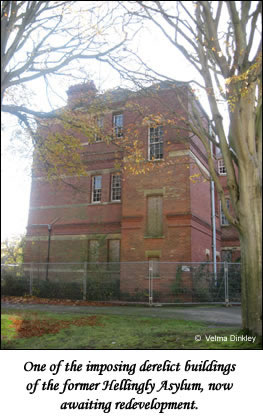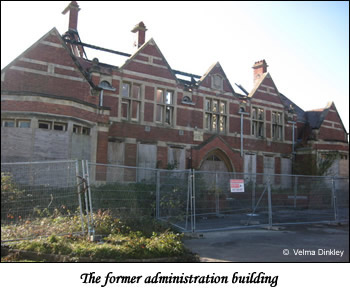When I first started researching my family, my cousin told me that she once heard a story of how our maternal grandmother’s uncle had drowned in a pond, so I set out to discover who it was.
My grandmother, Josephine Packham, was born in 1907 in Fletching, Sussex. Her mother, my great grandmother Maud Guilford, had a younger brother who was killed in World War One in Belgium, so it couldn’t have been him, which left it to be one of her father’s six brothers, Henry, Alfred, Edward, Frederick, George or Frank.

I had already visited the church of St Andrew and St Mary the Virgin in Fletching and had found the graves of Alfred, Edward, Frederick and Frank, so knew their dates of death. Whilst I couldn’t find a grave for George, I did have a copy of the distribution account for his estate. George was a bachelor and had died in 1923 at the age of 48, leaving his estate to his many nieces and nephews. No doubt you can imagine what a great help this has been with my research, however, I was still no further forward in finding out which one had drowned.
Fletching is quite near to Piltdown, where in 1908 fragments of a skull were found, which were believed to be the evolutionary ‘missing link’, although it was later proved to be a hoax. I had heard stories that my grandmother’s brothers had learnt to swim in the pond there, so felt certain that this was where he died. Perhaps he had been taking a dip and had got into difficulty.
In fact, I was so sure that this uncle had drowned in Piltdown Pond, that when I found an inquest detailed on the A2A website, held at East Sussex Record Office, for a George Packham who had drowned in a pond in Courtlands Wood, Nutley, just north of Fletching, in 1923, I immediately dismissed this find. Admittedly, I was fairly new to genealogy at the time.
Instead, my attention was drawn to Frederick and Frank, who had died at the relatively young ages of 36 and 21 respectively. Perhaps they too had swam in the pond, just as their nephews would later do.
I ordered their death certificates online through the General Record Office and discovered through them that Frederick had died of internal injuries after being kicked by a horse at his mother’s farm and that Frank had died of Phthisis (Pulmonary TB). So it wasn’t either of them.
Unwilling to spend a small fortune on death certificates, I looked again at the entry for George Packham on the A2A website and began to wonder if this could well be my great x2 uncle after all, so ordered his death certificate.
The certificate confirmed that he did indeed drown in a pond in Courtlands Wood, Nutley, and that his cause of death was recorded as “suicide whilst of unsound mind”.
I immediately contacted East Sussex Record Office requesting a copy of the inquest report and several weeks later it arrived in the post.

The report recorded that George had a history of mental illness and had spent several months of 1916 in Hellingly Asylum near Hailsham, Sussex, as well as several weeks in 1918 in St John’s Hospital in Sevenoaks. His doctor stated that, ”Since 1916 he has been childish in his manner and in talking”.
I did know of Hellingly Asylum, which was situated several miles north of Eastbourne, where I was brought up. I remembered stories of how ‘escaped’ inmates would wander the local lanes, causing much alarm to residents.
It was opened as the East Sussex County Asylum in 1903 near to the village of Hellingly, and had its own electrified railway connecting it to Hellingly railway station, on the now defunct Eridge to Polegate line, to transport coal to the hospital, as well as a small number of patients and visitors. Most of the hospital closed in 1994 and awaits redevelopment, although some buildings are still in use.
At the time of his death, George worked as a farm labourer in Nutley for a Mr Rush, with whom he also lodged. He had spent several days ill in bed with a cold, but had a awoken on the Sunday morning, missed breakfast and went out without returning.
He was missing for three days, until he was found face down in the pond by his brother, Edward. His coat had been neatly laid on the bank and his watch had been placed in one of the pockets. Given his history of mental illness the inquest concluded that he had taken his own life.
So, I had discovered the uncle who had drowned in the pond, but what had caused his mental illness? His spells in the asylums were during World War One, so perhaps this was a result of his military service. I searched the WW1 records, which were available on the internet at the time, but could find no reference to George.

The answer came when I was nearing the end of one of my infrequent visits to Lewes Record Office. It had been a rather unsuccessful trip, searching through their transcribed parish records for various family members, and I was about to call it a day, when I spotted a book listing the obituaries reported in the Sussex Express newspaper, which were held on microfilm at the record office.
Looking under ‘Packham’ I found an entry for George, as well as one for his mother, my great x2 grandmother Mary Ann, who had died in 1916. I managed to find the correct film and with help from the staff there, loaded it up onto the spools. The obituary provided more information about George, as well as explaining why he had taken his own life. Evidently he had stopped developing mentally at the age of 15, was childish in his behaviour and had imaginary grievances. He was seen as someone as a little strange, a bit of an oddball, and people would jeer at him, something which would upset him greatly. He just wanted to be left alone and at times was very depressed.
Apparently his ‘condition’ was deteriorating in the weeks up to his death. He had a fear of doctors and was terrified of being sent back to Hellingly.
So rather sadly, my great x2 uncle, George Packham, suffered from a mental illness, which in this day and age would have a name attached to it and treatment would readily be available. He wasn’t any harm to anyone, just a quiet, unassuming man who just wanted to be left alone. Yet the only option available to him was to be locked away in an asylum. One can only imagine what he experienced there during his stay seven years previously, but it was the threat of returning there which led him to take his own life.
Velma Dinkley
© Velma Dinkley 2009
Further Reading
Abandoned Britain: Hellingly Asylum